
Asclepias is a genus of herbaceous, perennial, flowering plants known as milkweeds, named for their latex, a milky substance containing cardiac glycosides termed cardenolides, exuded where cells are damaged. Most species are toxic to humans and many other species, primarily due to the presence of cardenolides, although, as with many such plants, there are species that feed upon them and from them. Most notable are monarch butterflies, who use and require certain milkweeds as host plants for their larvae.
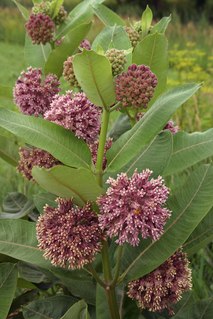
Asclepias syriaca, commonly called common milkweed, butterfly flower, silkweed, silky swallow-wort, and Virginia silkweed, is a species of flowering plant. It is native to southern Canada and much of the United States east of the Rocky Mountains, excluding the drier parts of the prairies. It is in the genus Asclepias, the milkweeds. It grows in sandy soils as well as other kinds of soils in sunny areas.

Asclepias asperula, commonly called antelope horns milkweed or spider milkweed, is a species of milkweed native to the Southwestern United States and northern Mexico.

Asclepias curassavica, commonly known as tropical milkweed, is a flowering plant species of the milkweed genus, Asclepias. It is native to the American tropics and has a pantropical distribution as an introduced species. Other common names include bloodflower or blood flower, cotton bush, hierba de la cucaracha, Mexican butterfly weed, redhead, scarlet milkweed, and wild ipecacuanha.

Asclepias fascicularis is a species of milkweed known by the common names narrowleaf milkweed and Mexican whorled milkweed. It is a perennial herb that grows in a variety of habitats.

Asclepias erosa is a species of milkweed known commonly as desert milkweed. It is native to southern California, Arizona, and northern Baja California, where it is most abundant in the desert regions.
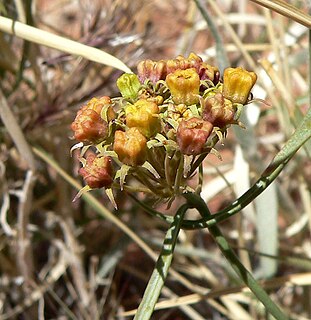
Cynanchum utahense is a species of flowering plant in the genus Cynanchum of the family Apocynaceae, known by the common names Utah swallow-wort and Utah vine milkweed. This relatively uncommon perennial vine is native to the Mojave Desert from California, Nevada, Utah and Arizona in the United States. This is a small vine with a highly branched, twining stem rarely exceeding a meter in length with which it physically supports itself on other shrubs and trees. It has small narrow leaves a few centimeters long. Its flowers are bright yellow to orange and grow in umbels. The fruit is a grooved follicle several centimeters long.

Asclepias cordifolia is a species of milkweed commonly called heart-leaf milkweed or purple milkweed. It is native to the western United States, growing between 50 to 2,000 m elevation in the northern Sierra Nevada and Cascade ranges. Heart-leaf milkweed was valued by the Native American Miwok tribe for its stems, which they dried and processed into string and rope.
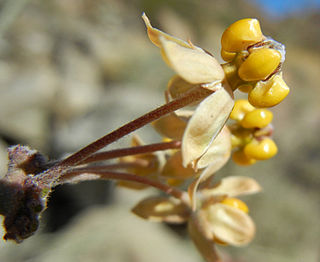
Asclepias albicans is a species of milkweed known by the common names whitestem milkweed and wax milkweed. It is native to the Mojave and Sonoran Deserts of California, Arizona, and Baja California. This is a spindly erect shrub growing usually 1 to 3 meters tall, but known to approach four meters. The sticklike branches are mostly naked, the younger ones coated in a waxy residue and a thin layer of woolly hairs. Leaves are ephemeral, growing in whorls of three on the lower branches and falling off after a short time. They are linear in shape and up to 3 centimeters long. The inflorescence is an umbel appearing at the tips of the long branches and sprouting from the sides at nodes. The inflorescence contains many small purple-tinted greenish flowers, each with a central array of bulbous hoods, and corollas reflexed back against the stalk. The plant may flower in any season except summer. The fruit is a large, long, thick follicle which dangles in bunches from the branch nodes.

Boechera breweri is a species of flowering plant in the family Brassicaceae known by the common name Brewer's rockcress.
Neokochia californica is a species of flowering plant in the subfamily Camphorosmoideae of the amaranth family known by the common name rusty molly. It is native to the valleys and deserts of southeastern California and adjacent parts of Nevada, where it grows in dry, alkaline soils such as alkali flats and desert washes. This is a perennial herb or small shrub growing one or more sprawling, branching stems to a maximum height near 60 centimeters. The stems are lined with narrow, elongated, somewhat flattened fleshy leaves up to about a centimeter long. The leaves and stem are coated in grayish or brownish hairs. The inflorescence is made up of one or more tiny hairy flowers sprouting from the axils of the leaves.
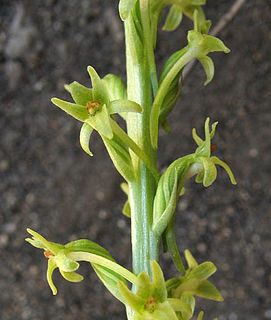
Platanthera elongata is a species of orchid known by the common names denseflower rein orchid, chaparral orchid and wood rein-orchid. It is native to western North America from British Columbia and Montana to southern California, where it grows in mountain forests and scrub habitat. This orchid grows erect to about 1.3 meters in maximum height from a bulbous caudex, its stem becoming narrow toward the tip. The basal leaves are up to 30 centimeters long by 6.5 wide. Leaves higher on the stem are much reduced. The upper part of the stem is a spikelike inflorescence of many small green flowers which are sometimes densely arranged. They are sometimes faintly and variably fragrant in the evenings. The spur on each flower may be up to 1.5 centimeters long.
Psilocarphus elatior is a species of flowering plant in the family Asteraceae known by the common names tall woollyheads, meadow woollyheads and tall woolly-marbles. It is native to the Pacific Northwest in western North America from Vancouver Island, where it is known from just a few occurrences, to northern California. It grows in seasonally moist spots such as meadows, spring seeps, and vernal pools.
Streptanthus barbiger is a species of flowering plant in the mustard family known by the common name bearded jewelflower. It is endemic to California, where it is limited to the North Coast Ranges. It grows in woodlands and chaparral habitat, often on serpentine soils. It is an annual herb producing a branching stem up to about 80 centimeters in maximum height. Leaves near the base of the stem are lance-shaped to oval and pointed, usually with toothed edges, the blades measuring up to 7 centimeters long. Leaves higher on the stem may be longer but are narrower and have smooth edges. Flowers occur at intervals along the upper stem. Each has a spherical to urn-shaped calyx of greenish yellow or purple sepals under a centimeter long. Whitish or purple-tinged petals up to a centimeter long emerge from the tip. The fruit is a long, flat, curving silique which may be 7 centimeters in length.

Tricardia is a monotypic genus of flowering plants in the borage family containing the single species Tricardia watsonii, which is known by the common name threehearts. It is native to the southwestern United States, where it grows in deserts and mountains in sandy open habitat, often beneath shrubs. It is a perennial herb growing from a taproot and a woody caudex covered with the shreddy remains of previous seasons' herbage. It produces several erect stems up to about 40 centimeters tall. Most of the leaves are located in a basal rosette about the caudex. They are lance-shaped and coated thinly in woolly hairs. They are up to 9 centimeters long and are borne on petioles. A few smaller leaves occur higher on the stem. Flowers occur in a loose cyme at the top of the stem. Each has a calyx of five sepals. The outer three are heart-shaped and green to pink or purple in color, and the inner two are much smaller and narrower. The flower within is bell-shaped, white with central purple markings, and roughly half a centimeter wide. The fruit is a capsule just under a centimeter long which contains 4 to 8 seeds.
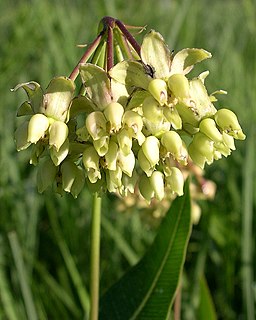
Asclepias meadii is a rare species of milkweed known by the common name Mead's milkweed. It is native to the American Midwest, where it was probably once quite widespread in the tallgrass prairie. Today much of the Midwest has been fragmented and claimed for agriculture, and the remaining prairie habitat is degraded.

Asclepias welshii is a rare species of milkweed known by the common name Welsh's milkweed. It is native to southern Utah and northern Arizona, where there are four known occurrences remaining. Most of the plants occur in Coral Pink Sand Dunes State Park, where the habitat has been degraded in many areas by off-road vehicle use. It is a federally listed threatened species of the United States.
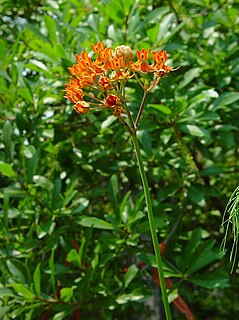
Asclepias lanceolata, the fewflower milkweed, is a species of milkweed that is native to the coastal plain of the United States from New Jersey to Florida and Southeast Texas. A. lanceolata is an upright, perennial plant that can grow between 3 and 5 feet tall, with red-orange flowers blooming in the summer months. It can also be referred to as Cedar Hill milkweed, as it was first described by Dr. Eli Ives in the neighborhood of Cedar Hill in New Haven, Connecticut.

Asclepias sullivantii is a species of flowering plant in the milkweed genus, Asclepias. Common names include prairie milkweed, Sullivant's milkweed, and smooth milkweed. It is native to North America, where it occurs in the central United States and Ontario in Canada.
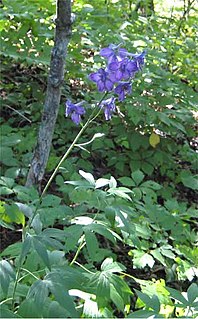
Delphinium exaltatum, known by the common name tall larkspur, is a species of flowering plant in the genus Delphinium, part of the buttercup family. Other Delphinium species are also commonly known as tall larkspur, such as Delphinium barbeyi. D. exaltatum is native to the central and eastern United States, where it can be found in Kentucky, Maine, Ohio, Pennsylvania, Maryland, West Virginia, Virginia, North Carolina, Alabama, Tennessee, and Missouri.

















